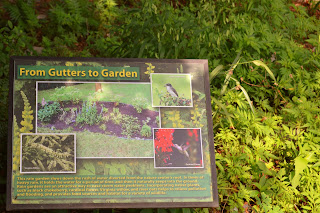The Rain Garden at Hemlock Bluffs
Across the courtyard from the steps in front of the classroom building is a lush green vegetative spot where a rain garden has been installed. A rain garden is designed to route rain water off the roof, through the gutters, into pipes then into a garden which slowly releases the water into the nearby landscape. In this case, the woods.
 |
| An educational sign in the garden explains how the rain garden works. |
 |
| Park Operations Manager, Mark Johns uses the Rain Garden as an example when he teaches about native plants and wildlife gardening. |
Several species of native plants are included in the rain garden to include blooms throughout the growing season. A few suggested successful rain garden plants are shown below.
 |
| Netted Chain Fern |
 |
| Cardinal Flower |
 |
Christmas Fern Watch the rain garden throughout the year as you visit the nature preserve, it looks different in every season. |
No comments:
Post a Comment